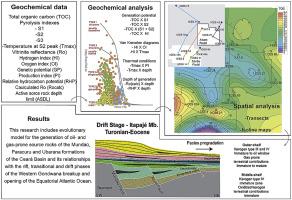Journal of South American Earth Sciences ( IF 1.7 ) Pub Date : 2020-12-24 , DOI: 10.1016/j.jsames.2020.103092 Ana Clara B. de Souza , Daniel R. do Nascimento , Alessandro Batezelli , Francisco Nepomuceno Filho , Karen M. Leopoldino Oliveira , Narelle Maia de Almeida , Márcio N. Normando , Thiago H. da Silva Barbosa

|
The Mundaú sub-basin composes the western segment of the Ceará Basin, which is one of a series of basins of the Brazilian Equatorial Margin that resulted from the breakup of Western Gondwana. This study investigates the origin and maturation of the organic matter preserved in the rocks of the middle and outer shelf of the Mundaú sub-basin, in order to assess the source-rock potential for oil and gas generation. The samples selected for this study are representative of the Mundaú, Paracuru, and Ubarana formations, which correlate with the rift, transition, and drift phases of the Western Gondwana breakup. The results indicate moderate to good potential for oil generation and good potential for gas generation for the Mundaú Formation. Fault activity during the rift phase favored sediment supply. Kerogen type III predominates in shallower portions and probably reflects the contribution from the continent. Good to excellent potential for oil and gas generation is indicated for the Paracuru Formation. Kerogen types I and II predominate, having the marine organic matter been deposited in reducing conditions. The most promising interval for hydrocarbon generation is limited by the top of the Trairí Member and the top of the Paracuru Formation. Moderate to good potential for oil and gas generation is suggested for the Uruburetama Member of the Ubarana Formation. The source rocks located in the middle shelf were deposited under reducing conditions in a transgressive marine environment. Kerogen varies from type II, to a mixture of types II and III, and to subordinate type III. Poor to fair potential for oil generation is indicated for the Itapajé Member of the Ubarana Formation. Kerogen type IV (inert or degraded) is typical in the middle shelf, and kerogen type IV and subordinate type III are typical on the outer shelf. The presence of inert kerogen is related to high-energy, oxidizing depositional environments. The hydrocarbon expulsion threshold estimated for the outer shelf is at 2106-m, for the middle shelf at 1635-m, and for the deep waters at 3632-m depths. Source rocks of the middle and outer shelves occur between 561 m and 4080 m, whereas those in deep waters occur between 2754 m and 5007 m of depth. The Active Source Rock Depth Limits (ASDL) estimated for the outer shelf is below 4500 m, whereas for deep waters, this limit is close to 6000 m. These organic geochemical constraints are important guidelines for oil and gas exploration in the Ceará and adjacent basins.
中文翻译:

地球化学对巴西赤道边缘塞拉盆地白垩纪烃源岩分布的制约
Mundaú子盆地构成了塞阿拉盆地的西部部分,该盆地是西贡多瓦纳破裂导致的一系列巴西赤道边缘盆地之一。本研究调查了Mundaú子盆地中部和外部架子的岩石中保存的有机物的起源和成熟度,以评估产生油气的源岩潜力。选择用于该研究的样品代表了Mundaú,Paracuru和Ubarana地层,这与西刚德瓦纳破裂的裂谷,过渡和漂移阶段有关。结果表明,Mundaú组的产油潜力中等至良好,而天然气的潜力则良好。在裂谷期的断层活动有利于沉积物的供应。干酪根III型在较浅的部分占主导地位,可能反映了该大陆的贡献。帕拉库鲁组的油气产生潜力具有很好的潜力。I型和II型干酪根占主导地位,海洋有机物在还原条件下沉积。最有前途的生烃间隔受到Trairí成员顶部和Paracuru组顶部的限制。建议Ubarana组的Uruburetama成员具有中等至良好的油气生产潜力。位于海陆架中段的烃源岩在还原条件下在海侵环境中沉积。干酪根的类型从II型到II型和III型的混合物,再到从属III型。乌瓦拉纳组的Itapajé成员表示,其潜在的产油潜力不大。中间架子上通常有IV型干酪根(惰性或降解),而外部架子上通常有IV型干酪根和下级III型。惰性干酪根的存在与高能氧化沉积环境有关。外层架的碳氢化合物排放阈值估计为2106-m,中层架的碳氢化合物排放阈值为1635-m,深层水域为3632-m。中层和外层的烃源岩发生在561 m至4080 m之间,而深水区的烃源岩发生在2754 m至5007 m的深度之间。估计的外层架活动源岩深极限(ASDL)低于4500 m,而对于深水区,该极限接近6000 m。











































 京公网安备 11010802027423号
京公网安备 11010802027423号